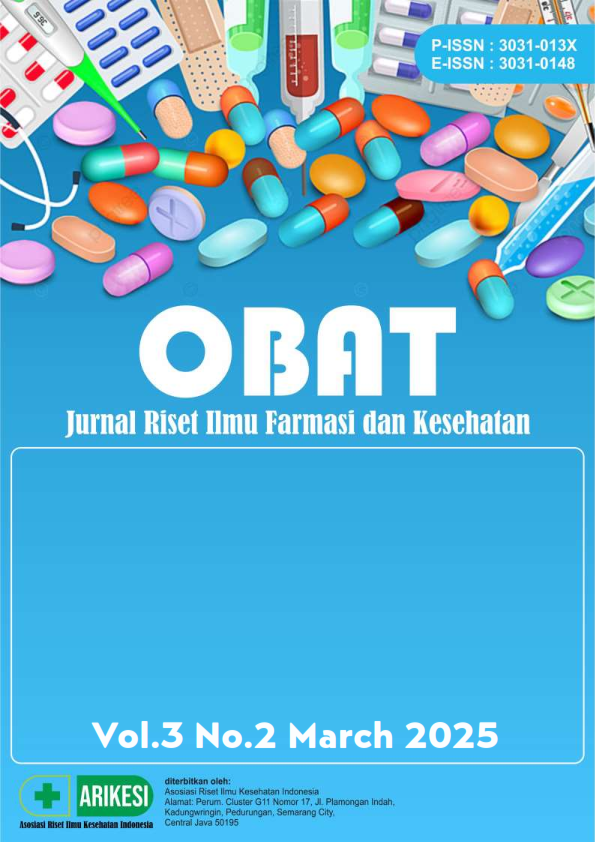Komunikasi dan Sikap Mahasiswa Berhubungan dengan Pencegahan Seks Bebas
DOI:
https://doi.org/10.61132/obat.v3i2.1199Keywords:
Behavior, Knowledge, PreventionAbstract
Factors contributing to the occurrence of promiscuous sexual behavior include internal and external elements. Internal factors include low self-control, lack of religious understanding, and low sexual knowledge. External factors include family and peers; peer association can influence both positive and negative behaviors. Positive behaviors include participating in beneficial activities with peers, while negative behaviors include violating social norms, such as having casual sex. This research design uses an analytic correlation approach, with the aim of finding the relationship between variables, data collection is done by questionnaire. Using the chi square formula with the help of SPSS, 125 students were asked to answer. The results showed that of the 125 study respondents, most were 21 years old, 36.8 percent, and the majority were female, 58.4%. In addition, the results of the analysis showed that 46% of the respondents showed a good level of knowledge, while 47% showed sufficient attitude and preventive behavior. Conclusion: There is a correlation between knowledge and preventive behavior of promiscuous sex.
Downloads
References
Azwar, S. (2015). Sikap Manusia: Teori dan Pengukurannya. Yogyakarta: Pustaka Pelajar.
Azwar, S. (2018). Reliabilitas dan Validitas. Yogyakarta: Pustaka Pelajar.
Fitri, A., & Naimah, T. (2020). Hubungan antara pengetahuan dan sikap dengan perilaku seksual pada remaja. Jurnal Kesehatan Reproduksi, 8(2), 120-130.
Glanz, K., Rimer, B. K., & Viswanath, K. (2008). Health behavior and health education: Theory, research, and practice (4th ed.). San Francisco: Jossey-Bass.
Handayani, F., Sari, R. P., & Purnama, Y. (2020). Peran pendidikan seksual dalam meningkatkan kesadaran remaja terhadap seks bebas. Jurnal Pendidikan dan Konseling, 2(3), 89-98.
Notoatmodjo, S. (2010). Promosi Kesehatan dan Ilmu Perilaku. Jakarta: Rineka Cipta.
Notoatmodjo, S. (2018). Metodologi Penelitian Kesehatan. Jakarta: Rineka Cipta.
Putri, R. A., Nugroho, W. S., & Kusuma, R. A. (2019). Pengaruh lingkungan sosial terhadap perilaku seksual remaja. Jurnal Ilmu Sosial dan Humaniora, 4(1), 45-55.
Rahmawati, A., Widodo, A., & Susanti, D. (2020). Hubungan sikap terhadap kesehatan reproduksi dengan perilaku seksual remaja. Jurnal Keperawatan dan Kebidanan, 6(1), 34-42.
Rosenstock, I. M. (1974). The Health Belief Model and preventive health behavior. Health Education Monographs, 2(4), 354-386.
Santrock, J. W. (2019). Life-span development (17th ed.). New York: McGraw-Hill.
WHO. (2022). Adolescent sexual and reproductive health. World Health Organization. Retrieved from https://www.who.int/reproductivehealth.
Putri, R. A. (2018). Pengaruh Pengetahuan Kesehatan Reproduksi terhadap Perilaku Seksual Remaja di Kota X. Jurnal Kesehatan Masyarakat, 7(2), 115-120.
Notoatmodjo, S. (2012). Teori dan Promosi Kesehatan. Jakarta: Rineka Cipta.
Santrock, J. W. (2021). Life-span development: A topical approach (19th ed.). New York: McGraw-Hill.
Downloads
Published
How to Cite
Issue
Section
License
Copyright (c) 2025 OBAT: Jurnal Riset Ilmu Farmasi dan Kesehatan

This work is licensed under a Creative Commons Attribution-ShareAlike 4.0 International License.





